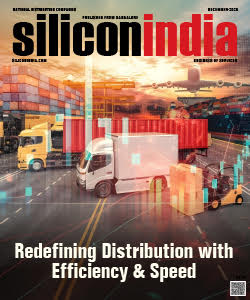Comparing the Global and Indian Supply Chain Management Sector

In a recent interaction with Siliconindia, Hima Parvataneni , CEO & Director, Navata Supply Chain solutions shares her opinion on the difference between Indian Supply chain and global supply chain environment. Hima, an alumini of BITS- Pilani and Master's in engineering management, focusing on decision sciences from Duke University, USA. She has worked there for about 15 years across industries, starting from strategy consulting, market research. She moved back to India around five years ago joined family business, Navata Road Transport.
In what manners does strategy for managing the global supply chains differs from the strategy adopted for supply chain in India, specifically concerning the use of technology?
The main challenge is the strategy for most industries. All supply chain leaders are aligned on the impact technology can bring in and they have charted out technology roadmaps. But some industries in India, like apparel and automotive industry, for example, are much more advanced and are almost at par with the global industries in terms of automation, integrating from their supplier to their end customer, the whole value chain using technology in the warehouses and integrating with their transportation partners till the time of delivery for visibility.
But when you look at the more traditional industries, we can see a significant gap in India versus globally, industries such as FMCG, Packaged food, Paints, Agro, which contribute the bread and butter of the country; I feel they are still in a very nascent stage of technology adoption. There is a huge lack of visibility because every customer is dealing with 20 to 30 vendors, be it warehouse vendors or transportation vendors. And this whole unorganized state of working is leading to lack of visibility in terms of inventory and also in terms of cost.
There is a stat that says that 95% of supply chains must quickly react to the changing conditions. But currently in India, only 7% are able to execute decisions in real time, which is crazy because there is a huge data coming in, there is huge focus on ML and AI in the current market. But because of this lack of integration and unorganized market, the data is not flowing in a clean way where the decisions are still not being made. So there is a gap, people are working towards automating even these traditional industries, which might take a little longer time.
Which are the major problems that Indian supply chains have to overcome in order to reach similar levels of effectiveness and robustness as their foreign counterparts?
One of the major problems that I feel that India is facing is the extreme cost pressure. If you look at the global supply chain, SCM costs are estimated at 8% typically of country's GDP. But in India, they contribute to anywhere between 12-14% of the country's GDP. Moreover there is a huge growth of e-commerce and omni-channel where the supply chain leaders had to build over their currently fragmented supply chain and make it even more complex with more unorganized vendors and all to meet the customer expectation. So there is pull from both sides, from the customer and also from the cost pressure, because of which the supply chain has become very fragmented and unorganized.
The second challenge is the last mile logistics, where it is one of the most expensive parts of the end-to-end transportation. It contributes to overall 20% of all transportation costs and reaching the rural customer is a little more challenging in India which most global supply chains don't face. And as said earlier, this whole unorganized and fragmented thing is bringing in the lack of visibility in terms of overall cost and visibility.
How do cultural and economic factors shape the supply chain practices and policies in India in relation to the global trends?
There are lots of in general cultural practices that negatively impact the current logistics industries which the industry is currently trying to break through. One of them is the dignity of labor, the entire logistics workforce, starting from drivers to the various traders that are involved in the workforce, be it mechanics, it is very dependent on the labor because there's still complete automation is not available. Because of dignity of labor the industry is facing huge shortage in terms of manpower. But if we see to the more advanced nations like United States or Europe, it's a respectable profession, being a logistician is a respectable profession. So I think that attitude change needs to be here in India.
The other important aspect is diversity within the logistics industry. It is heavily male dominated and Women until a decade ago also not consider it is a safe industry to come join and over 90% of the workforce is male. So with more diversity comes different thought processes and different changes, which I feel is missing in the current logistics industry.
Another cultural and economical factor that is impacting us is the regulatory compliances that the government is bringing in, mostly in the positive way. Like GST, which has brought a lot of positive change, which is good. Like there is a huge movement between states in an easier manner. But there is a something called eBay bill management, which is a huge burden for all the transporters and logistics companies in the country. And there are loopholes, which is also driving corruption.
How does sustainability differ in Indian supply chains than the global supply chains and what measures are being taken to support sustainable practices?
Primarily if you look at advanced companies like EU members, US and Japan, they have much more stringent regulations around carbon emissions, waste management and labor practices. I feel we are just getting started on that journey. Most of the multinational companies do have a sustainable practice agenda, which starts from integrating all their suppliers to end customers across the value chain, setting sustainable practices in terms of packaging, in terms of use of vehicles, in terms of delivery and waste management. But the same has not trickled down to the mid-level companies completely yet. The use of renewable energy and IoT and EV vehicles is just getting, taking an upper trend as we speak.
EV vehicles have taken up, are growing in a good rate for last mile deliveries, but we still have to evaluate the line haul and for longer journeys, how do we bring in sustainability? And also how do companies think about sustainability from an end-to-end corporate leadership level, where they set proper goals, monitor them on a regular basis, rather than just having them as a charter in their stakeholder reports. So there is a gap which needs to be filled when we talk about sustainability at mid-level to lower-level companies, which contribute a major chunk of Indian economy.
How do supply chain strategies of India have different effects of geopolitical risks and global trade compared to other countries?
Geopolitically, one of the main things that India is trying to do is reduce its dependency in manufacturing, dependency on China.
Like we have seen during the time of COVID, how several industries have gotten stuck up because of the containers getting stuck in the route. So strengthening the sea routes and reducing the dependency on China in manufacturing can be done by focusing on within Make in India campaign. Strengthening our own infrastructure through the national logistics policy, which talks about bringing in a huge national logistics policy, which talks about end-to-end integration? The government is also heavily investing in multimodal facilities like rail and also improving our own infrastructure in terms of roads. Other than that, they're also evaluating options in other Southeast Asian countries that can help build our manufacturing capabilities to the next level.
India's supply chain is at a very important stage at this point, where the whole country sees supply chain as a backbone for running the country. Everyone realizes that the industry needs to focus on automation, needs to focus on culturally making, giving dignity of labor to all the people involved and bringing in diversity. We are also seeing a lot of good technology innovations coming from the country to solve individual use cases using IoT, AI, ML, and all these new technologies. So the next 5 to 10 years, we are going to see a significant growth where we might even beat the global advanced nation’s supply chains, how they work.
Read More News :

.jpg)
.jpg)


